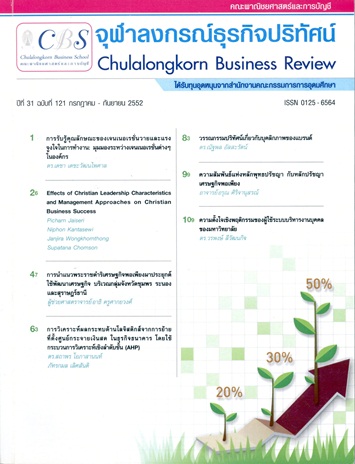การนำแนวพระราชดำริเศรษฐกิจพอเพียงมาประยุกต์ใช้พัฒนาเศรษฐกิจ บริเวณกลุ่มจังหวัดชุมพร ระนองและสุราษฎร์ธานี
Main Article Content
Abstract
บทคัดย่อ
การวิจัยเรื่องการนำแนวพระราชดำริเศรษฐกิจพอเพียงมาประยุกต์ใช้พัฒนาเศรษฐกิจบริเวณกลุ่มจังหวัดชุมพร ระนองและสุราษฎร์ธานี โดยมีวัตถุประสงค์ศึกษาคุณลักษณะส่วนบุคคลทั่วไปของประชากรตัวอย่าง ศึกษาระดับการนำแนวพระราชดำริเศรษฐกิจพอเพียงมาประยุกต์ใช้ เปรียบเทียบการนำแนวพระราชดำริเศรษฐกิจพอเพียงมาประยุกต์ใช้ ศึกษาปัจจัยคุณลักษณะส่วนบุคคลทั่วไปที่มีความสัมพันธ์กับการนำแนวพระราชดำริเศรษฐกิจพอเพียงมาประยุกต์ใช้ และศึกษาปัญหาที่เป็นอุปสรรคต่อการพัฒนาเศรษฐกิจบริเวณกลุ่มจังหวัดชุมพร ระนองและสุราษฎร์ธานี ตามแนวพระราชดำริเศรษฐกิจพอเพียง พร้อมแนวทางพัฒนาเศรษฐกิจพอเพียง เป็นงานวิจัยเชิงปริมาณ ผสมผสานกับเชิงคุณภาพ เครื่องมือที่ใช้ประกอบด้วยแบบสอบถามและแบบสัมภาษณ์ ทดสอบเครื่องมือ 40 ตัวอย่าง ได้ค่าความเที่ยง 0.9474 เก็บข้อมูลด้วยแบบสอบถาม 1,200 ตัวอย่าง และเก็บแบบสัมภาษณ์ จำนวน 90 ตัวอย่าง ด้วยวิธีเฉพาะเจาะจงและพบปะบังเอิญ สถิติที่ใช้ประกอบด้วย ค่าร้อยละ ค่าเฉลี่ย ค่าส่วนเบี่ยงเบนมาตรฐาน ค่า t-test วิเคราะห์ความแปรปรวนทางเดียว ANOVA ทดสอบอัตราส่วนด้วย F-test และทดสอบสมมุติฐานการวิจัยด้วยค่าไคสแควร์ เก็บตัวอย่างกลุ่มประชากรตัวอย่างจังหวัดชุมพร ระนองและสุราษฎร์ธานี จาก 3 จังหวัด 25 อำเภอ 50 ตำบล และ 50 หมู่บ้านเพื่อการวิจัย ผลการวิจัยมีดังนี้
1. คุณลักษณะส่วนบุคคลทั่วไปของประชากรตัวอย่าง พบว่ากลุ่มตัวอย่างที่ใช้เป็นตัวแทนในการศึกษาครั้งนี้ส่วนใหญ่เป็น เพศหญิง มีอายุระหว่าง 21 – 30 ปี สำเร็จการศึกษาระดับมัธยมศึกษาตอนปลายหรือเทียบเท่า นับถือศาสนาพุทธ เป็นโสด มีจำนวนบุคคลในครอบครัวที่ต้องรับภาระเลี้ยงดู 3 – 4 คน ประกอบอาชีพนักเรียนนักศึกษา พนักงาน ลูกจ้าง เกษตรกรรม มีรายได้รวมเฉลี่ยเดือนละ 3,001 – 5,000 บาท ขนาดการถือครองที่ดินมากกว่า 5 ไร่ ไม่มีที่ดินของตนเอง ร้อยละ 47.25 เป็นคนในพื้นที่โดยกำเนิด และไม่ได้ดำรงตำแหน่งหน้าที่ทางสังคม
2. ระดับการนำแนวพระราชดำริเศรษฐกิจพอเพียงมาประยุกต์ใช้พัฒนาเศรษฐกิจบริเวณกลุ่มจังหวัดชุมพร ระนองและสุราษฎร์ธานี ในภาพรวมประกอบด้วยมิติ 5 ด้าน ได้แก่ มิติด้านเศรษฐกิจ มิติด้านสังคม มิติด้านทรัพยากรธรรมชาติและสิ่งแวดล้อม มิติด้านเทคโนโลยีและมิติด้าน
จิตใจ ผลการศึกษาพบว่า กลุ่มจังหวัดมีการนำแนวพระราชดำริเศรษฐกิจพอเพียงมาประยุกต์ใช้พัฒนาเศรษฐกิจบริเวณกลุ่มจังหวัด อยู่ในระดับมาก โดยมีค่าเฉลี่ย 3.61 และค่าส่วนเบี่ยงเบนมาตรฐานเท่ากับ 0.60
3. ผลเปรียบเทียบการนำแนวพระราชดำริเศรษฐกิจพอเพียงมาประยุกต์ใช้พัฒนาเศรษฐกิจบริเวณกลุ่มจังหวัดชุมพร ระนองและสุราษฎร์ธานี ในภาพรวมพบว่า มีค่าเฉลี่ยแตกต่างกันอย่างมีนัยสำคัญทางสถิติที่ระดับ 0.05 กล่าวคือ จังหวัดชุมพรมีการนำแนวพระราชดำริเศรษฐกิจพอเพียงมาประยุกต์ใช้พัฒนาเศรษฐกิจบริเวณกลุ่มจังหวัดมากกว่าจังหวัดระนองและจังหวัด สุราษฎร์ธานี ขณะที่จังหวัดระนองมีการนำมาประยุกต์ใช้พัฒนาเศรษฐกิจมากกว่าจังหวัดสุราษฎร์ธานี
4. ผลการทดสอบสมมุติฐาน ปัจจัยคุณลักษณะส่วนบุคคลทั่วไปของประชากรตัวอย่าง กลุ่มจังหวัดชุมพร ระนองและสุราษฎร์ธานี ที่มีความสัมพันธ์กับการนำแนวพระราชดำริเศรษฐกิจพอเพียงมาประยุกต์ใช้พัฒนาเศรษฐกิจบริเวณกลุ่มจังหวัด ผลการทดสอบพบว่า อายุ ระดับการศึกษา สถานภาพการสมรส และการประกอบอาชีพ มีความสัมพันธ์กับการนำแนวพระราชดำริเศรษฐกิจพอเพียงมาประยุกต์ใช้ ส่วนปัจจัยด้าน เพศ การนับถือศาสนา จำนวนบุคคลในครอบครัว ระดับรายได้ การถือครองที่ดิน ภูมิลำเนา และตำแหน่งหน้าที่ทางสังคม ไม่มีความสัมพันธ์กับการนำแนวพระราชดำริเศรษฐกิจพอเพียงมาประยุกต์ใช้พัฒนาเศรษฐกิจบริเวณกลุ่มจังหวัดดังกล่าว
Abstract
This is a research of applying the royal initiative about Sufficiency Economy in developing the economy of Chumporn, Ranong and Suratthani provinces with the purpose of studying general personal characteristics of sample population, their level of applying the sufficiency economy principle, comparing the application of the sufficiency economy principle, studying general personal characteristics with relations to applying the sufficiency economy principle, and studying problems obstructing economic development of Chumporn, Ranong and Suratthani provinces according to the principle, and development guidance for sufficiency economy. It was a quantitatively and qualitatively mixed research. Questionnaires and interview forms were used in testing 40 samples for tools. The reliability value is 0.9474. There were 1,200 questionnaire samples and 90 interview samples collected by private and incidental selection. Statistics used were percentage, average, standard deviation, T-Test, one-way ANOVA, ratio test using F-Test, and hypothesis test using Chi-Square Test. Sample population were collected from Chumporn, Ranong and Suratthani – 3 provinces, 25 districts, 50 sub-districts, and 50 villages. The research results are as follows:
1. General Personal Characteristics of the Sample Population: It was found that most representing samples used in this study were female aged between 21-30, had high-school level of education or equivalent, were Buddhists, single, had 3-4 family dependents, worked as students, employees, agriculturists, had average total income between 3,001-5,000 Baht, possessed land of more than 5 rai. The number of 47.25 percent of them had no their own land. Being inhabitants by birth, they had no social function titles.
2. Level of applying Sufficiency Economy principle: Overall, there were 5 dimensions i.e. economic, social, natural and environmental resources, technological, and mental dimensions. The study results indicate a that Sufficiency Economy has been used in economic development of the group provinces at high level with average value of 3.61 and standard deviation value of 0.60.
3. Comparison of applying Sufficiency Economy principle: Overall, the averages were significantly different at the level of 0.05 i.e. the principle has been adopted by Chumporn in developing the economy in the provinces more than Ranong and Suratthani did, while Ranong adopted it more than Suratthani.
4. Hypothesis Test of General Personal Characteristics of the Samples from the Three Provinces with Relations to the Application of the Sufficiency Economy in Economic Development of the Group Provinces: The testing results indicate that age, education level, marital status and occupation do have relations to Sufficiency Economy adoption, while such factors as gender, religion, number of family members, income level, land possession, domicile, and social function title have no relations to applying the Sufficiency Economy in economic development of the provinces.
Article Details
Opinions and discussions in papers published by the Creative Business and Sustainability Journal (CBSJ) are deemed as personal opinions and the responsibility of the writers. They are not the opinions or responsibility of the Chulalongkorn Business School of Chulalongkorn University.
Papers, content, information etc. appearing in the Journal are deemed to be the copyright property of the Chulalongkorn Business School of Chulalongkorn University. Anybody or any organization that wishes to publish any part of them or use them in any way must obtain written permission from the Chulalongkorn Business School, Chulalongkorn University.


